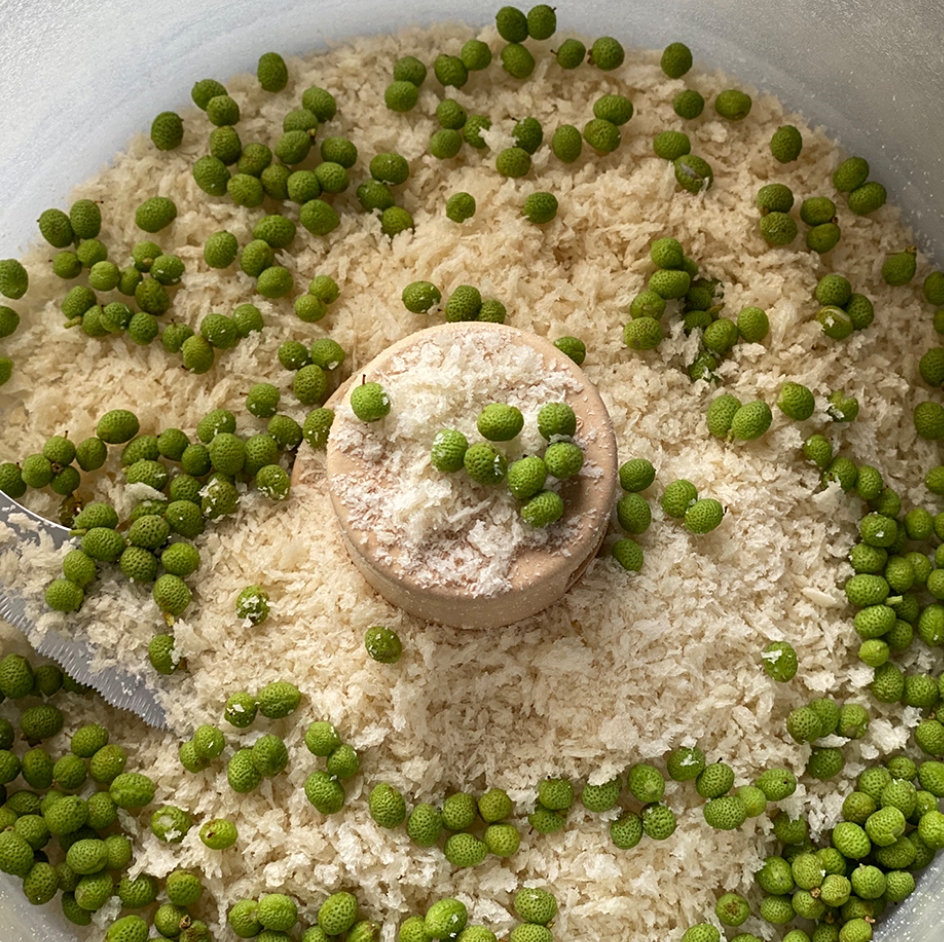Budo sansho panko


 Ingredients(Serves 4 People)
Ingredients(Serves 4 People)
- Panko:50g
- Budo sansho (Mi-zansho):20g
- ※This recipe uses frozen mi-zansho.
If fresh mi-zansho are not available, it can be substituted with about 1/2 teaspoon of frozen or dried sansho.
Instructions
- Add the panko and the plucked sansho peppers to the food processor.
- Process until the mi-zansho are the same size as the panko.
- Once the crumbs are evenly separated, transfer to a bowl. (Leftover panko can be frozen for later use.)


Saltimbocca with Budo Sansho


Saltimbocca is a local dish from Rome, Italy, made by layering and baking thin slices of beef, prosciutto and sage. This is an original recipe inspired by the saltimbocca, that carefully wraps ingredients with thin slices of meat, that are breaded and fried. The budo sansho perfectly complements the pork, which is combined with the panko and fried to a crisp. The savory taste of the prosciutto makes this a no-fail recipe that requires no seasoning or basting.
 Ingredients(Serves 4 People)
Ingredients(Serves 4 People)
- Thinly sliced pork (Pork loin):200g
- Prosciutto:100g
- A Egg(Whole):1 egg
Milk:50ml
Flour:2 Tablespoons - Budo Sansho Panko:as needed
- Vegetable Oil:as needed
- ※This recipe uses frozen mi-zansho.
If fresh mi-zansho are not available, it can be substituted with about 1/2 teaspoon of frozen or dried sansho.
Instructions
- Mix together A, making sure not to form lumps to make the batter.
- Place a piece of prosciutto on a piece of pork and coat the entire surface with batter [A], followed by the budo-sansho panko.
- Heat oil to 160-170 degrees celsius. Add (2), and deep-fry until golden brown on both sides.
- Plate on a serving dish. Squeeze a pinch of citrus fruit on top to finish.
◎Tips
Make sure to fry at a lower temperature to prevent the budo sansho to get burnt.


Budo-Sansho Bottarga


 Ingredients(Serves 2 People)
Ingredients(Serves 2 People)
- Panko:50g
- Budo-sansho(Mi-zansho):20g
- Anchovies:2 slices
- Olive Oil:30ml
- Garlic:1 Clove
- ※This recipe uses frozen mi-zansho.
If fresh mi-zansho are not available, it can be substituted with about 1/2 teaspoon of frozen or dried sansho.
Instructions
- Heat the crushed garlic and olive oil on low heat in the frying pan and bring out the garlicky fragrance.
- When you start to smell the garlic, break up the anchovies and add the panko.
- When the panko have absorbed the oil and is crispy, transfer the mixture to a vat.


Budo Sansho Bottarga Pasta


In Sicily, there is a dish for the poor called “cucina povera”, which is a pasta dish which substitutes crunchy panko and anchovies instead of cheese.
It is quick to make and has an mouthwatering aroma and an addictive flavor with the touch of the tangy budo sansho that will keep you coming back for more. It can be served with seafood or meat, or for toppings of gratin and salad.
 Ingredients(Serves 2 People)
Ingredients(Serves 2 People)
- Olive Oil:20ml
- Garlic:1 Clove
- Small Squid:4 pieces
- Salt:a pinch
- Garum(Can substituted with fish sauce):2 Teaspoon
- Pasta water:1 Cup
- Pasta:180g〜200g
- Salt:As needed ※generous amount
Instructions
- Put the pasta in boiling water and make sure to be generous with the salt so that it is well seasoned.
- Heat the crushed garlic and olive oil on low heat in the frying pan and bring out the garlicky fragrance.
- Quickly fry the prepared squid to (2) , then add the pasta water and salt.
※Be careful to be light on the seasoning, as the budo sansho and bottarga are already flavorful. - Transfer the cooked pasta to (3), add the garum and oil (as needed), and allow it to emulsify.
- Arrange the pasta on a plate and then garnish with the budo sansho and bottarga.
◎Tips
It is recommended for pasta, sprinkled on sautéed fish or meat, grilled with casseroles, or as a topping for salads.


Budo Sansho Peposo


When people hear sansho, they often think of it as something that’s tedious to prepare, requiring to picking from the branches and removing the bitter residue.
Since sansho has a short season, it is often boiled or pickled to preserve it for a longer period of time, but I’ve fallen in love with the natural spicy flavor of sansho, so I prefer to always use the raw sansho as is.
“Pepe” is Italian for black pepper. Pepe is the origin of the word Peposo, which is a local dish of Florence.
Originally, this dish is made with beef, red wine, and a lot of peppercorns or ground pepper, but we replaced the black pepper with budo sansho peppers, and using the entire branch. This is a simple stew that only requires a little preparation and is ready to go straight into the oven. Try it with pork, chicken, or wild boar meat.
 Ingredients(Serves 4 People)
Ingredients(Serves 4 People)
- Beef(Shank):600g
- Garlic:1 Clove
- Onion:1 Whole
- Olive oil:As needed
- Budo sansho(Mi-zansho from stalk):60g
- A Bay leaf:1 leaf
Red wine:450ml
Salt:1/2 Teaspoon
Brown sugar:2 Tablespoons(can use other sugars)
Dark soy sauce:1 Tablespoon
Instructions
- Chop the beef shank into large chunks and rub with salt.
- Finely chop the garlic and onion and fry in olive oil.
- Sear the beef in a frying pan, and when it is browned on all sides, combine with (2).
- In the same pan as (3), add A and a sprig of washed mi-zansho pepper.
- Remove any accumulated impurities that float up to the top and simmer in a preheated oven at 180℃ for 1 hour.
- Remove from the oven, and if there is a lot of broth, heat the pot over high heat and reduce to a simmer.
- Portion onto a plate and serve.
◎Tips
※Temperature and baking time will vary depending on your oven, so please adjust accordingly.
Though red wine for stews can be easily purchased at a reasonable price, but if you happen to find the Tuscan "Chianti Classico", I'd definitely recommend using this wine.



Nichijousahan
Presenting dishes that make the most of the seasonal ingredients with the idea of “making everyday life a little richer”.
We bring together seasonal and local ingredients with food related events, original products, and delicious recipes.
https://www.nichijo-sahan.com/
For daily food scenes, visit the link below.


 Recipes using budo sansho
Recipes using budo sansho





